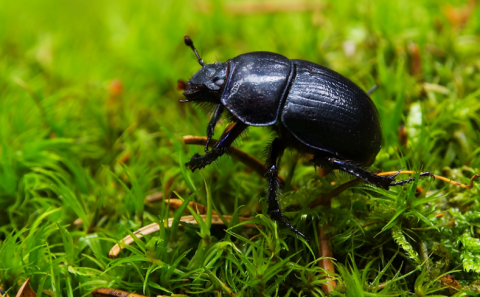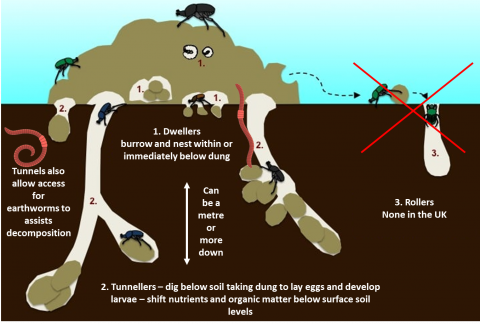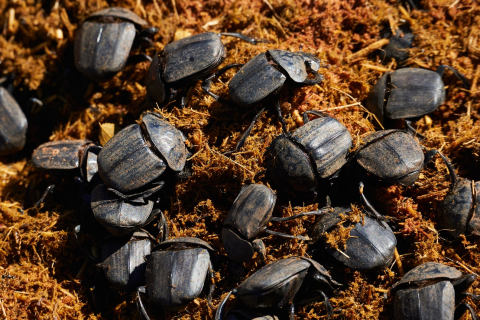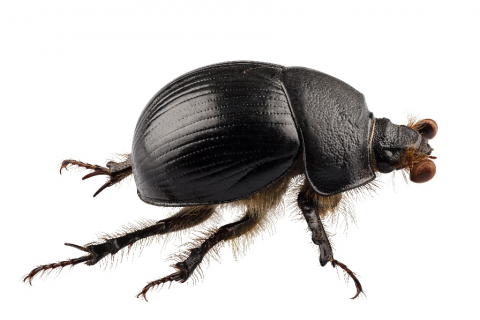18 March 2021
Dr David Cutress: IBERS, Aberystwyth University.
- Dung beetles are nature's bin men, removing waste and supporting its further breakdown
- Manure can be a key source of food for dung beetles, however, farm grazing and animal drug treatment strategies are having negative impacts on populations
- Several simple changes could encourage dung beetle activity on pastures and help farms benefit from the ecosystem services they provide
What are dung beetles?
Beetles are insects of the order Coleoptera within which there is a superfamily subgroup called the Scarabaeoidea. The Scarabaeoidea contains groups of beetles that either partially or fully rely on faeces as a food source, these are more commonly called dung beetles. Dung beetles can be further grouped based on their feeding/breeding behaviours into three major groups, the ‘dwellers’, ‘tunnellers’ and ‘rollers’.
Adapted from Heritage Tours & Safaris
Based on information from the ‘Dung Beetle UK Mapping Project’ (DUMP) there are approximately 60 species of dung beetle found in the UK, however, 25% of these are ‘Nationally Rare’ and four species have become extinct within the last 50 years according to their recent report. Dung beetles are vital for agriculture as they play key roles in decomposition of livestock faeces, however, their current risk and decline is likely largely due to past agricultural practices and as such future practices may need to consider this.
What role do they play in the ecosystem?
Dung beetles play a key role in ecosystems in many ways and as such, they are often highlighted for the ecosystem services (ES) they provide. Essentially an ecosystem service is any benefit provided by an ecosystem that contributes beneficially towards human life. This can be anything from providing food to providing spiritual/recreational areas for humans to utilise. A quick overview of some of the ecosystem services provided is shown in the table below;
|
Beetle activity |
Effect |
Ecosystem service provided |
|
Remove dung from pastures |
Prevents pasture growth being hindered |
Increases available energy for livestock to convert to food for humans |
|
Removes barrier to livestock grazing |
||
|
Reduces habitats for dung flies |
Prevents pests impacting livestock increasing the yields achieved and reducing costs of treatments |
|
|
Reduces survivability of gastrointestinal parasites |
||
|
Removes a potential disease vector from soil surface |
Disease control |
|
|
Transport dung into soil layers |
Cycles nutrients and organic matter into soils |
Increases soil potential for pasture growth increasing livestock productions, decreasing fertiliser requirements and increasing soil carbon stocks |
|
Tunnelling into faeces and soil |
Increases soil aeration and penetration |
Reduces compaction eases the flow of air, water and nutrients to benefit pasture growth |
|
Increased oxygenation of faeces |
Potentially decreases methane fluxes (see below for GHG emission debate) |
|
|
Allows access for other decomposers like earthworms to faeces |
Increases nutrient cycling into the soil for increased pasture growth increasing livestock production, decreasing fertiliser requirements and increasing soil carbon stocks |
|
|
Transport seeds from dung |
Bury seeds from dung in nutrient-rich soil |
Impacts on global biodiversity and long-term pasture systems |
|
Presence in environment |
Acts as a food source for predators such as local birds and bats |
Improves biodiversity |
|
Carry and transport mites |
Mites predate on eggs of dung flies |
Prevents pests impacting livestock increasing the yields achieved and reducing costs of treatments |
ES (often linked with the concepts of public goods) play an ever-increasing role in the future scope of agriculture and the UK landscape broadly as experts indicate that payment/incentive schemes should be focusing on ES to add value to our natural capital. As such farmers may see direct monetary benefits in the future to facilitating aspects which may inherently benefit dung beetle ecosystems. It is also important to note that insects on the whole play many other roles in ES including through pollination, biological control and as a potential food source and have been highlighted recently for their risk of extinction.
As indicated above there are some considerations with regards to dung beetle activity having impacts on greenhouse gases (GHGs) and thus on climate change. Much research has indicated that the activity of dung beetles in breaking down and aerating dung pats leads to reductions in key GHG emissions including nitrous oxide (N2O), carbon dioxide (CO2) and methane (CH4). Specific findings within these studies have indicated that emission reductions are greatest where a mixture of dung beetle species are present, however, often some gas emissions are reduced, whilst others are increased. Whilst an influential paper suggested that dung beetle activity could reduce GHG emissions from individual dung pats by up to 7%, several more recent studies dispute these beneficial claims indicating either neutral impacts or net increases in emissions. Discrepancies in outputs are likely due to studies in vitro and on pasture having differing variables that can confound results thus further research is required.
Despite the uncertainty with regards to climate-based ecosystem benefits, dung beetles play key roles in cycling nutrients. This ultimately impacts much of the surrounding biodiversity including soil microbiota and fungal populations in a variety of complex ways, as such the continued loss of these species could have untold knock-on effects on soil health and functionality.
How they impact agriculture?
A study in the UK estimated that dung beetles may be directly saving the cattle industry £366 million annually (the table below provides a breakdown). Similarly, assessments in tropical regions have demonstrated equivalent benefits such as an indicated benefit of between $140 - $455 million in the Mexican cattle industry. Furthermore, it was calculated that if agricultural dung was not broken down its accumulation could remove 4.8% of pasture availability each year. The main areas dung beetles were seen to be economically impacting agricultural practices in the above estimations where through;
- Reducing pest flies
- Reducing livestock gastrointestinal (GI) parasites
- Reducing pasture fouling
- Increasing agricultural pasture nutrient cycling
Note that the figures above are concerning the cattle industry only and dung beetles will also have further impacted on other outdoor grazing animal systems such as sheep and goats though these have lower overall economic values.
|
Ecosystem service (Cattle systems) |
Benefit (£ year−1) |
||||
|
Conventional |
Organic |
Conventional + organic |
|||
|
Total |
Per cow |
Total |
Per cow |
Total |
|
|
Control of face flies |
7 452 188 |
0.79 |
250 208 |
0.84 |
7 702 396 |
|
Control of horn flies |
35 526 127 |
3.76 |
1 186 887 |
3.97 |
36 713 014 |
|
Control of GI parasites |
188 603 229 |
19.96 |
7 180 271 |
23.99 |
195 783 500 |
|
Reduced pasture fouling |
58 588 398 |
6.20 |
1 887 909 |
6.31 |
60 476 307 |
|
Increased nutrient cycling |
63 372 397 |
6.71 |
2 504 968 |
8.37 |
65 877 365 |
|
Total benefit |
353 542 339 |
37.42 |
13 010 243 |
43.47 |
366 552 582 |
Assessments on dung beetle nutrients cycling have indicated specific roles for tunnelling species where studies combined these with herbage growth. Studies demonstrated higher herbage yields and nitrogen (N) content thus overall increased feed values of pasture growth where dung beetles are present. The burial of faeces by these dung beetles assists in returning N lost in dung to the soil and could work towards reducing N losses which can be substantial in agricultural practices (minimising the need for N fertiliser addition). In more recent assessments evaluating other plant parameters when grown in the presence or lack of manure with beetles, it was further confirmed that beetle trials led to beneficial impacts on soil health as well as increasing leaf sugar content, vitamin C and overall photosynthetic rates.
Dung beetles’ impact on pests, including flies and GI parasites occur in a variety of ways. Dung beetles have an associated relationship with Macrochelidae mites which parasitise beetles, whilst these can have detrimental impacts on beetles many species directly predate dung fly eggs and larvae and use beetles for transport acting as a form of biological control. Interaction between dung beetles and pest flies may well also involve direct competition for food which reduces survivability of fly larvae. These roles add benefits as pest flies are associated with reducing animal welfare and spreading or facilitating certain livestock diseases which can lead to significant production losses.
GI parasites are another major concern in agriculture, having impacts on animal health and welfare and leading to productivity losses globally. The successful survival of these parasites through to re-infection of livestock is largely dependent on the warm moist environment that dung provides. Dung beetle activity (alongside improved earthworm dung access) can help to aerate, dry out and physically remove dung (inclusive of parasite eggs) all of which is unfavourable for parasite development and continued infection.
How agriculture impacts them?
Agricultural practices such as indoor overwintering, temporal vegetation cover (winter cover crops), conversion from grazing to arable land and any grazing strategies which lead to fields lacking grazing can all impact the availability of habitat (dung on pasture) for beetle development and survival. Alongside these factors, antiparasitic compounds applied to livestock by farmers have been repeatedly demonstrated to remain at substantial levels in the faeces they excrete. Many of these compounds can have a detrimental effect on dung beetles with varying levels of toxicity.
Taken from fact sheet 2 'Dung Beetles Direct' backed by multiple studies 1, 2, 3,4
Ivermectin is key from these as it is the most popular livestock anthelmintic in the UK. In experimentation, it was shown that the average retention time of most antiparasitic drugs into active defecation of animals was 14 days post-treatment. This indicates that treating animals at key periods of the year can be a positive managerial action to reduce impacts on dung beetles at pasture. Even sublethal levels of certain parasite treatments may impact beetle communities with recent studies finding negative effects on reproduction abilities and body shape and size with macrocyclic lactones (ivermectin and doramectin) and synthetic pyrethroids. Similarly, antibiotics have been noted to be retained in animal faeces and impact cattle microbial population as well as the environmental bacteria in the soil and beetle internal microbiomes. Whilst direct impacts on dung beetles due to this change in the microbiome is currently understudied, it is noted that antibiotic presence in dung has a detrimental impact on antimicrobial resistance (AMR) developing and may negatively impact GHG emissions through their impacts on soil ecosystems.
Whilst there are clear detriments to UK beetles due to certain farm practices, it was estimated that increasing their protection through a combination of methods such as reducing, or stopping entirely, any unnecessary treatment of adult cattle with anthelmintics could save a further £46.4 million a year across the cattle sector. Protection strategies suggested have been the inclusion of defined protection measures incorporated into agricultural environment schemes and organic accreditation schemes as incentivised approaches.
Improvement strategies
In the UK there are several strategies which farmers could utilise, many of which have other beneficial impacts.
- Egg count before treating for internal parasites – Only treating animals with active parasite burdens can reduce costs, improve general flock health, reduce the potential of chemical resistances and reduce faeces containing chemicals harmful to beetles
- Use targeted chemicals rather than broad-spectrum – reduce resistance and select chemicals which harm dung beetles least
- Avoid moving pastures following parasite treatment – If feasible treat during indoor periods to reduce pasture contamination or dedicate a pasture for post-treatment
- Avoid treating animals during the dry weather periods where parasite transfer risk is lowest but dung beetle activity is still high
- Weigh animals before treating – this avoids under-dosing animals which leads to increased treatments and resistances thus more chemicals impacting dung beetles
- Grazing strategies which encourage rotation and particularly rotation of different animal species provides a constant and varied manure source for beetles and can have dual impacts on GI parasites
- Avoid complete indoor overwintering if possible – providing a few animals which winter outdoors can assist beetles by providing faeces for nutrients during this period
- Reduce antibiotic usage – whilst exact implications of antibiotics on dung beetles are unclear, reductions can have many other beneficial impacts in reducing farm costs, environmental impacts and antibiotic resistance
- Mixed farming – combining crops with livestock particularly in permanent long-term systems could boost available land for dung beetles to thrive and if optimised can be more environmentally friendly
There is also interest within individuals and research groups in the UK towards finding more innovative solutions to the plight of the dung beetle. Certain projects are looking at the impacts of re-introducing UK species varieties onto farms, with some aiming to have a supply centre for British farmers to buy and repopulate dwindling beetle populations to encourage their wide ES benefits.
Summary
Dung beetles can offer a variety of benefits to farmland from increasing soil nutrient cycling to actively deterring livestock pests of high economic importance. Farming practices can be involved in actively damaging beetle populations but luckily, they can also be adapted to help. Many simple managerial changes can be performed on farms to help dung beetle populations thrive and recover, with many of these strategies having associated knock-on economic and environmental benefits for farmers. With the ongoing shift in agricultural subsidies towards public goods and environmental impact, now is the perfect time for farms to look into how they can implement strategies to benefit dung beetles and other key ecosystem species.





